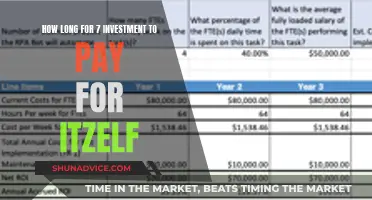
Investing is something you can never start too early. The earlier you start, the more time your money has to grow. If you start investing with just $3,600 per year at age 22, assuming an 8% average annual return, you'll have $1 million by the time you're 62. But if you wait until you're 32, you'll have to save $8,200 per year to reach that same goal.
There are many ways to invest, including stocks, bonds, mutual funds, cryptocurrency, and NFTs. The goal is always the same: to grow your money. One of the main growth drivers when it comes to investing is compound interest, which accrues on both the initial deposit and the accumulated interest from previous periods.
- Decide how much money you have to invest.
- Where to start investing: consider a brokerage account, which is a taxable account that allows you to buy and sell stocks, bonds, mutual funds, and other types of investments without a fear of penalty.
- Know your investment options: savings accounts, certificates of deposit (CDs), money-market funds, stocks, bonds, mutual funds, exchange-traded funds (ETFs), and index funds.
- Diversify your investments across a wide variety of sectors and risk levels.
- Do your homework and understand the risks: low-risk investments such as savings accounts or CDs see smaller gains and smaller losses, while high-growth stocks or cryptocurrencies can make or lose you money quickly.
- Choose what to invest in: well-diversified ETFs or index funds are recommended by experts.
| Characteristics | Values |
|---|---|
| When to start investing | As early as possible, even while in college |
| How much to invest | As much as possible, but at least $50-$100 per month |
| Where to invest | 401(k) with matching dollars, emergency fund, Roth IRA, traditional IRA, taxable brokerage account |
| How to invest | Diversify your portfolio, invest in mutual funds, index funds, ETFs, stocks, bonds |
| Risk | Higher-risk investments may make or lose you a lot of money quickly |
What You'll Learn

Invest in a 401(k) with matching dollars
Investing in a 401(k) is one of the main ways that many US workers build up savings for retirement. It's a "tax-advantaged" investment account, meaning that the money you contribute to it each year, typically a percentage of each paycheck, lowers your taxable income.
- Contribute enough to your 401(k) to at least maximise your employer's contribution. If your employer matches your contribution, make sure you're contributing enough to take full advantage of this. Otherwise, you're leaving money on the table.
- Understand your risk tolerance. All investing is risky, but keeping too much of your savings in cash can also be risky due to inflation. Determine an appropriate asset allocation, or how much of your investments will be in stocks (also known as equities) and how much will be in safer investments, like bonds. Generally, the younger you are, the more risk you can afford to take.
- Pick your investments. You'll typically be choosing from a selection of mutual funds or exchange-traded funds (ETFs), which invest in a variety of companies and sectors. Do your research before making your selections—you can use a site like Morningstar to assess each fund's fees, performance over time, and what companies, sectors, stocks and/or bonds make up the fund.
- Diversify your investments to mitigate risk. While many funds are already diversified, you can further diversify by spreading your money over several funds.
- Minimise expense ratios. Expense ratios are the fees carried by investments, and they range widely. When given a selection, pick the lowest-cost option, often an index fund. Even small differences in fees can have a huge effect over time.
Billionaires' Investment Secrets
You may want to see also

Set up an emergency fund
Setting up an emergency fund is one of the first steps you can take to start saving. By putting money aside for unplanned expenses, you can recover quicker and get back on track towards reaching your larger savings goals.
The amount you need to have in an emergency savings fund depends on your situation. Think about the most common kinds of unexpected expenses you’ve had in the past and how much they cost. This may help you set a goal for how much you want to have set aside. Financial expert Rachel Cruze recommends saving three to six months of living expenses in your emergency fund. However, the amount of money you aim to have in your emergency fund is up to you and will depend on your personal circumstances.
Where should I keep my emergency fund?
You want to make sure your emergency fund is safe, accessible, and in a place where you’re not tempted to spend it on non-emergencies. Here are a few options for where to put your emergency savings:
- Bank or credit union account
- Prepaid card
- Cash
Set some guidelines for yourself on what constitutes an emergency or unplanned expense. Not every unexpected expense is a dire emergency but try to stay consistent. A death in the family requiring an immediate plane trip, a car accident, or a job loss all qualify as both unexpected and valid reasons to dip into your emergency fund.
Retirement Investments: Living Off Profits
You may want to see also

Open a Roth IRA
A Roth IRA is a great way to start investing for retirement, especially if you're fresh out of college. Here's what you need to know about opening a Roth IRA:
Eligibility
First, you need to determine if you're eligible to open a Roth IRA. There are income limits, which can reduce or eliminate your ability to contribute to a Roth IRA. For example, for the year 2024, if you're under 50, you can contribute up to $7,000 per year to your Roth IRA if your modified adjusted gross income is below $146,000 (for single filers) or $230,000 (for married filing jointly). Above these income limits, the amount you're allowed to contribute starts to decrease, and Roth IRA contributions are not allowed at all for incomes above $161,000 (single filers) or $240,000 (married filing jointly).
Choosing a Provider
When it comes to choosing a provider for your Roth IRA, you have two main options: a brokerage or a robo-advisor. If you're a "do-it-yourself" investor who wants to pick your own investments, an online brokerage is a good choice. Look for a brokerage with a large selection of low-cost investment options, such as index funds and exchange-traded funds (ETFs). On the other hand, if you're a "manage it for me" type of investor, a robo-advisor might be a better fit. Robo-advisors are online services that build and maintain a diversified investment portfolio for you, taking the stress out of investing. While they do charge a small fee for their services, it's generally much lower than what a human financial advisor would charge.
Investment Amount
When deciding how much to invest in your Roth IRA, consider your budget, investing goals, and time horizon. It's generally recommended to invest only money that you won't need in the next five years, as this gives you time to weather any stock market volatility. Additionally, some investments, like mutual funds, may have minimum initial investment requirements, so be sure to take that into account.
Paperwork
Once you've chosen a provider, it's time to gather the necessary paperwork to open your Roth IRA account. This may include a valid form of ID, your Social Security number, proof of employment, beneficiary information, trusted contact information, and your bank account details for funding the account.
Picking Investments
Remember that a Roth IRA is just an account type—you also need to choose what to invest in. If you've opted for a robo-advisor, they will build and manage a diversified portfolio for you. If you're going the DIY route through a brokerage, consider building a portfolio of index funds and ETFs across different asset classes. Decide on your risk tolerance and how you want to allocate your investments between stocks, bonds, and cash. You can also look at model portfolios used by robo-advisors for inspiration. Just remember to periodically rebalance your portfolio to maintain your desired allocation.
Warehouses: An Overlooked Investment Haven
You may want to see also

Consider a traditional IRA
A traditional individual retirement account (IRA) is a great way to save for retirement and benefit from tax advantages. With a traditional IRA, you can contribute pre-tax income towards investments that grow tax-deferred. This means you won't pay taxes on any profits or dividends until you make a withdrawal from your IRA.
- Tax deductions: Contributions to a traditional IRA may be tax-deductible, depending on your income, tax-filing status, and other factors. For example, if you contribute $6,000 to your IRA, you can claim that amount as a deduction on your income tax return.
- Tax-deferred growth: Investments in a traditional IRA grow tax-deferred until you withdraw them during retirement. This allows your investments to compound over time without being reduced by taxes.
- Flexible contributions: There are no income limits for contributing to a traditional IRA. As long as you are working, you can keep contributing. The contribution limit for 2024 is $7,000, and if you are aged 50 or above, you can contribute an additional $1,000.
- Penalty-free withdrawals: While early withdrawals before the age of 59½ typically incur a 10% penalty, there are several exceptions where you can make penalty-free withdrawals. These include buying your first home, paying for higher education expenses, or unreimbursed medical expenses.
- No minimum balance: When setting up a traditional IRA, there is no minimum balance or starting investment required. You can start investing with as little as $1.
When deciding whether to open a traditional IRA, it's important to consider your current and expected future tax rates. Traditional IRAs are often recommended for investors who expect to be in lower tax brackets during retirement than they are currently in. This way, you can take advantage of tax deductions now and pay taxes at a lower rate when you withdraw during retirement.
Salomon Ski Investors: Who's Behind the Brand?
You may want to see also

Start with a taxable brokerage account
A taxable brokerage account is a versatile investment option. While it doesn't offer tax-deferred growth or immediate tax savings like retirement accounts, it is one of the most flexible tools for investors. You can build a portfolio that suits your risk appetite and use gains to improve your income and losses to offset your tax bill.
A taxable brokerage account is a type of investment account that allows investors to use after-tax dollars to buy various securities, such as stocks, bonds, mutual funds, and exchange-traded funds (ETFs). Since you buy investments with after-tax dollars, you don't get immediate tax benefits like with a traditional IRA or 401(k). However, taxable brokerage accounts offer other advantages.
One of the key benefits is flexibility. There are no contribution limits or penalties for early withdrawals, so you have complete control over your investments and can access your money whenever you need it. This makes taxable brokerage accounts ideal for short-term investment goals, such as saving for a down payment on a home or an unexpected expense.
Another advantage is the wide range of investment options available. You can invest in stocks, bonds, mutual funds, and ETFs, allowing you to create a diversified portfolio tailored to your financial goals. Additionally, taxable brokerage accounts offer potential tax benefits in the form of capital gains tax rates. Long-term capital gains, which apply to investments held for more than a year, are generally taxed at a lower rate than short-term capital gains.
When deciding whether to use a taxable brokerage account, consider the tax implications. While you won't receive immediate tax benefits, you will be subject to taxes on dividends, interest earned, and capital gains when you sell investments at a profit. The amount of taxes owed depends on factors such as the length of time the securities were held and your income tax bracket.
To open a taxable brokerage account, choose a brokerage firm that meets your needs, considering factors such as fees, investment options, and customer service. Complete an application form, providing personal and financial information. Once your account is open, fund it by depositing cash or transferring securities, and then start investing in the available assets.
In conclusion, don't underestimate the power of a taxable brokerage account. Its flexibility, investment options, and potential tax benefits make it an essential tool for building long-term wealth. By understanding its features and tax implications, you can make informed investment decisions and maximize your after-tax returns.
LLCs: Why Investors Are Wary
You may want to see also
Frequently asked questions
The best way to start investing is to contribute to a 401(k) plan if your employer offers one. This way, you can benefit from employer-matching contributions and avoid paying taxes on your contributions until you withdraw the money during retirement.
If you don't have access to a 401(k) plan, you should consider opening a Roth IRA or a traditional IRA account. With a Roth IRA, you contribute with money you've already paid taxes on, and distributions in retirement are tax-free. On the other hand, a traditional IRA gives you a tax deduction now, and you pay taxes on distributions later.
You can start investing with a small amount of money. Many brokers today offer low minimum deposits, and you can invest as little as $50 a month through automatic investing plans.
Some low-risk investment options include high-yield savings accounts, certificates of deposit (CDs), and money market funds. These options offer a secure way to store your money while earning a modest interest rate.
Common mistakes to avoid when investing for the first time include not doing enough research, investing more money than you can afford to lose, and not diversifying your investments across different sectors and risk levels.







